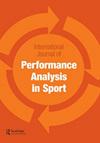Identifying which factors impact bowling and batting performances during the “death” phase of an innings in international men’s 50-over cricket
IF 2.1
4区 教育学
Q1 Health Professions
International Journal of Performance Analysis in Sport
Pub Date : 2023-03-04
DOI:10.1080/24748668.2023.2193030
引用次数: 2
Abstract
ABSTRACT In this study, 3,767 balls bowled by international-level fast bowlers across two One-Day International (ODI) tournaments were analysed to determine how to effectively bowl during the “death” phase of an innings (final 10 overs). The results of chi-squared analyses revealed that bowling length, bowling line, batter quality and having wickets in hand were all associated with the concession of runs during the death phase (all p < 0.001). Specifically, the yorker length is revealed to be very effective at restricting runs conceded, whereas the opposite is true for the half-volley and full-toss lengths. The batting side having five or more wickets in hand results in greater than expected runs being scored during the death phase. Furthermore, the results reveal that middle order batters score more runs than their tail-ender team-mates during this death phase, suggesting that middle-order batters have to assume the role of “finishers”. From a practical perspective, the results of this study clearly identify areas bowlers can target to constrict the scoring of runs as well as areas they should avoid. Batting strategies in the death phase should consist maintaining five or more wickets in hand and thereby not exposing tail-enders to the bowling attack.在国际男子板球50胜制比赛的“死亡”阶段,确定影响保龄球和击球表现的因素
在这项研究中,分析了国际水平的快速投球手在两场一日国际(ODI)锦标赛中打出的3767个球,以确定如何在一局(最后10轮)的“死亡”阶段有效地投球。卡方分析的结果显示,投球长度、投球线、击球手素质和手握三柱球都与死亡阶段的失分有关(均p < 0.001)。具体地说,客位长度被发现在限制失分方面非常有效,而对于半截击和全抛的长度则相反。在死亡阶段,拥有五个或五个以上三柱球的打击方得分高于预期。此外,结果显示,在这个死亡阶段,中档击球手比尾档队友得分更多,这表明中档击球手必须承担“终结者”的角色。从实际的角度来看,本研究的结果清楚地确定了投球手可以瞄准的区域来限制得分,以及他们应该避免的区域。在死亡阶段的击球策略应该包括保持五个或更多的三柱手,从而不暴露尾端保龄球攻击。
本文章由计算机程序翻译,如有差异,请以英文原文为准。
求助全文
约1分钟内获得全文
求助全文
来源期刊

International Journal of Performance Analysis in Sport
SPORT SCIENCES-
CiteScore
4.70
自引率
4.80%
发文量
38
审稿时长
>12 weeks
期刊介绍:
The International Journal of Performance Analysis in Sport aims to present current original research into sports performance. In so doing, the journal contributes to our general knowledge of sports performance making findings available to a wide audience of academics and practitioners.
 求助内容:
求助内容: 应助结果提醒方式:
应助结果提醒方式:


